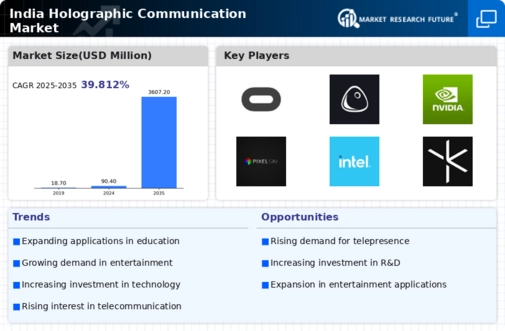Government Initiatives and Support
Government initiatives aimed at promoting digital transformation are significantly impacting the holographic communication market in India. Various policies and funding programs are being introduced to encourage research and development in advanced communication technologies. For instance, the Digital India initiative aims to enhance connectivity and promote innovative technologies across the nation. This supportive environment is likely to attract investments and foster collaborations between startups and established companies, potentially leading to a market growth rate of 20% over the next few years. Such initiatives are crucial for the advancement of the holographic communication market.
Rising Demand for Remote Collaboration
The need for effective remote collaboration tools is propelling the holographic communication market in India. As businesses increasingly adopt hybrid work models, the demand for immersive communication solutions that facilitate real-time interaction is on the rise. Holographic communication offers a unique advantage by providing a more engaging and interactive experience compared to traditional video conferencing. This shift is reflected in a projected market growth of around 30% by 2026, as organizations seek to enhance productivity and collaboration among remote teams. Consequently, the holographic communication market is becoming a vital component of modern business strategies.
Expanding Applications Across Industries
The holographic communication market in India is witnessing expansion across various industries, including retail, real estate, and tourism. Businesses are increasingly recognizing the potential of holographic technology to enhance customer engagement and provide immersive experiences. For example, real estate companies are utilizing holographic displays for virtual property tours, while retailers are employing holograms for interactive advertising. This diversification of applications is likely to drive market growth, with projections indicating an increase of approximately 28% in the next few years. As industries continue to explore innovative uses for holographic communication, the market is expected to flourish.
Technological Advancements in Holography
The holographic communication market in India is experiencing a surge due to rapid technological advancements. Innovations in display technologies, such as improved holographic projectors and augmented reality systems, are enhancing the quality and accessibility of holographic communication. The integration of artificial intelligence and machine learning into holographic systems is also streamlining processes, making them more efficient. As a result, the market is projected to grow at a CAGR of approximately 25% over the next five years. This growth is indicative of the increasing demand for immersive communication solutions across various sectors, including business and education, thereby driving the holographic communication market.
Increased Investment in Research and Development
Investment in research and development (R&D) is a key driver for the holographic communication market in India. Companies are increasingly allocating resources to innovate and improve holographic technologies, which is essential for maintaining competitive advantage. The focus on R&D is expected to lead to breakthroughs in holographic displays and communication systems, enhancing their functionality and user experience. This trend is supported by a growing number of startups and tech firms entering the market, which collectively contribute to an estimated market growth of 22% by 2026. Thus, R&D investments are pivotal for the evolution of the holographic communication market.
























Leave a Comment